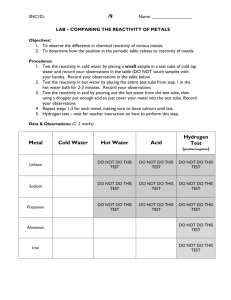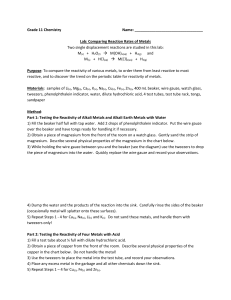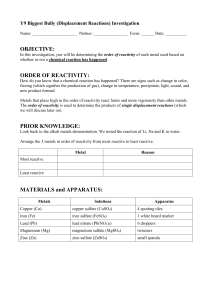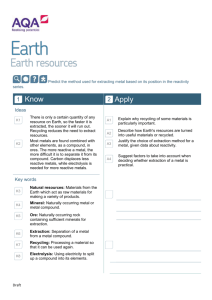Chem Periodicity. Lab Man. 101
advertisement
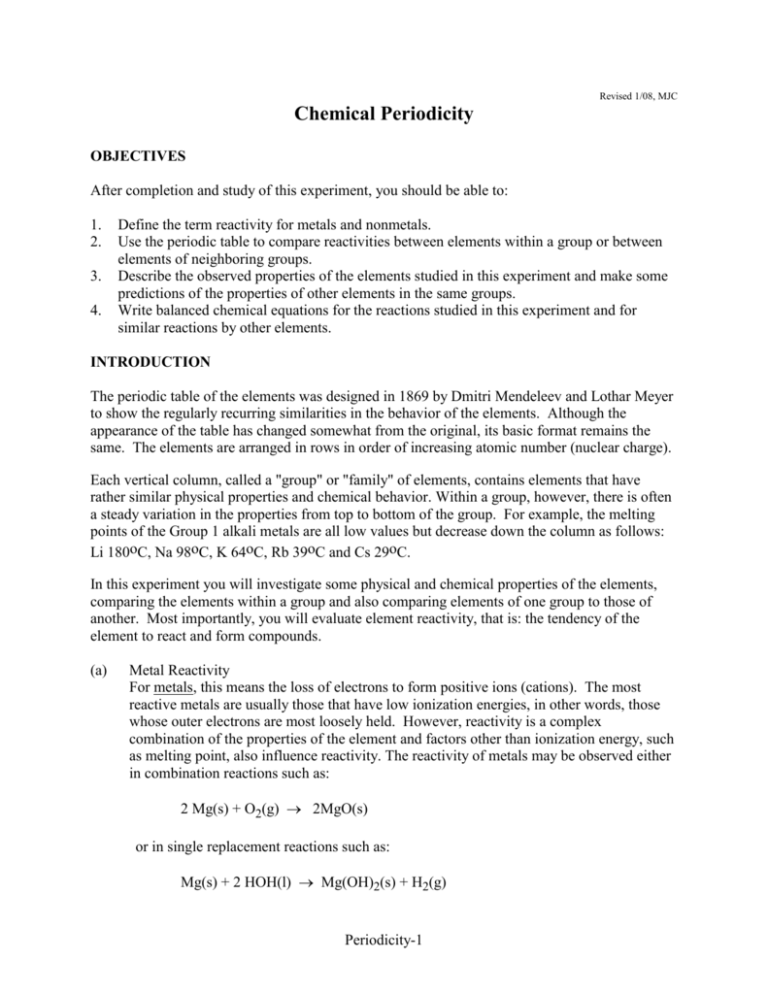
Revised 1/08, MJC Chemical Periodicity OBJECTIVES After completion and study of this experiment, you should be able to: 1. 2. 3. 4. Define the term reactivity for metals and nonmetals. Use the periodic table to compare reactivities between elements within a group or between elements of neighboring groups. Describe the observed properties of the elements studied in this experiment and make some predictions of the properties of other elements in the same groups. Write balanced chemical equations for the reactions studied in this experiment and for similar reactions by other elements. INTRODUCTION The periodic table of the elements was designed in 1869 by Dmitri Mendeleev and Lothar Meyer to show the regularly recurring similarities in the behavior of the elements. Although the appearance of the table has changed somewhat from the original, its basic format remains the same. The elements are arranged in rows in order of increasing atomic number (nuclear charge). Each vertical column, called a "group" or "family" of elements, contains elements that have rather similar physical properties and chemical behavior. Within a group, however, there is often a steady variation in the properties from top to bottom of the group. For example, the melting points of the Group 1 alkali metals are all low values but decrease down the column as follows: Li 180oC, Na 98oC, K 64oC, Rb 39oC and Cs 29oC. In this experiment you will investigate some physical and chemical properties of the elements, comparing the elements within a group and also comparing elements of one group to those of another. Most importantly, you will evaluate element reactivity, that is: the tendency of the element to react and form compounds. (a) Metal Reactivity For metals, this means the loss of electrons to form positive ions (cations). The most reactive metals are usually those that have low ionization energies, in other words, those whose outer electrons are most loosely held. However, reactivity is a complex combination of the properties of the element and factors other than ionization energy, such as melting point, also influence reactivity. The reactivity of metals may be observed either in combination reactions such as: 2 Mg(s) + O2(g) 2MgO(s) or in single replacement reactions such as: Mg(s) + 2 HOH(l) Mg(OH)2(s) + H2(g) Periodicity-1 In this experiment, you will compare the relative reactivity of several metals as they replace H2 from water. The loss of electrons by an element is an example of an oxidation process and involves a change from a lower to a higher (more positive) oxidation state. (b) Non-metal Reactivity Non-metals very frequently form negative ions in their reactions, particularly when combined with metals to form compounds such as NaCl, CaBr2, MgS, etc. The formation of negative ions involves the addition of one or more electrons to the non-metal atom. The most reactive non-metals should be those that have the strongest attraction for the added electrons. The reactivity of non-metals can be observed in combination reactions or in single replacement reactions such as: 2 NaBr(aq) + Cl2(aq) 2 NaCl(aq) + Br2(aq) In this type of replacement reaction, the more reactive non-metal is the one that changes from the free element to the negative ion. That is, this reaction is like a “competition” for the electron and the more reactive element (e.g., Cl2 above) “wins” the electron, while the less reactive element remains in the neutral, elemental form (e.g., Br2 above). The addition of electrons to an element is an example of a reduction process and involves a change from higher to lower (more negative) oxidation state. NOTE: 1. Your laboratory instructor will demonstrate the proper use of pH paper (Hydrion paper) and the conductivity probe. Use the stirring rod to transfer 1 drop of solution to the pH paper do not dip the paper. 2. Observe the following precautions when using the conductivity probe: a. b. c. d. Rinse the probe thoroughly between measurements as demonstrated by your instructor. Use small amounts of solutions. Only fill the container to height necessary to make a reading. Follow your instructor’s example. To achieve a uniform depth, dip the probe to the bottom of the container for each measurement. For this experiment, use the 0-20,000 toggle setting. Periodicity-2 PROCEDURE AND OBSERVATIONS PUT ON EYE PROTECTION Put on your EYE PROTECTION and keep it on throughout the experiment. Many of the substances used in this experiment are very reactive or caustic. A. Reactivities of Group 1, 2 and 13 Metals As a preliminary step check the pH (using pH paper) and conductivity of distilled water. Conductivity ______________________ pH _______________________ This information can be used to evaluate the results of the following parts of the experimental work. 1. Group 1 Metals (Alkali Metals) A. Lithium Use a forceps to obtain a small piece of lithium metal and wipe off the excess oil on a Kimwipe tissue. Before disposal of the Kimwipe, thoroughly saturate it with water to destroy any traces of metal. Do not touch the metal with your fingers. Observe the hardness of the metal by attempting to cut it with your spatula. Fill a small beaker (30 mL) about half full with distilled water and cautiously drop in the lithium metal, immediately covering the beaker with a watch glass. Observe carefully the reaction that occurs. When the reaction is complete, stir the solution and measure the conductivity and pH of the solution. Conductivity pH _______________________ The reaction of Li metal produces what positive ion? ______________________________ The high pH of the solution is due to what negative ion? ____________________________ What flammable gas was also produced in the reaction? ____________________________ Write a balanced equation for the reaction of Li(s) with H2O(l). _______________________________________________________________ Molecular form _______________________________________________________________ Ionic form If the water were boiled off from the solution, what solid substance would remain in the beaker? ___________________________ CHEMICAL DISPOSAL - Transfer the solution from the small beaker to a 250 mL beaker. Add two drops of phenolphthalein to the larger beaker. Set the 250 mL beaker aside to receive other waste solutions as directed. Periodicity-3 B. Sodium Using the same techniques used for lithium metal, cautiously add a small piece of sodium metal to distilled water in a small beaker. Compare the rate of reaction to that of sodium. Which element is more reactive? _____________________________ Again measure the pH and conductivity of the resulting solution. pH conductivity ________________ What ions are present in solution? ______________________________________ Write a balanced equation for the reaction of Na(s) with H2O(l). _____________________________________________________________ Molecular form _____________________________________________________________ Ionic form CHEMICAL DISPOSAL - Transfer the solution to the 250 mL waste beaker as was done for the lithium solution. Again, since the Kimwipe used in this portion of the experiment may carry traces of sodium metal, carefully wet it thoroughly to destroy the metals before disposing of it. C. Potassium Using the same techniques used for sodium metal, cautiously add a small piece of potassium metal to distilled water in a small beaker. Compare the reaction to that of lithium and sodium. Which element is most reactive? _____________________________ Again measure the pH and conductivity of the resulting solution. pH conductivity ________________ What ions are present in solution? ______________________________________ Write a balanced equation for the reaction of K(s) with H2O(l). _____________________________________________________________ Molecular form _____________________________________________________________ Ionic form Would cesium metal be predicted to be more or less reactive than sodium and potassium? Periodicity-4 CHEMICAL DISPOSAL - Transfer the solution to the 250 mL waste beaker as was done for the sodium solution. Again, since the Kimwipe used in this portion of the experiment may carry traces of sodium metal, carefully wet it thoroughly to destroy the metals before disposing of it. 2. Group 2 Metals (Alkaline Earth Metals) Calcium and Magnesium: Obtain pieces of Mg and Ca metal. If necessary, polish the Mg with steel wool or sandpaper to remove some of the oxide coating and expose bare metal. Place a small piece of each metal in separate small beakers containing distilled water (half full). Which metal is more reactive? ________________________ Test the pH and conductivity of each solution. pH Conductivity Mg ________________________ ___________________ Ca ________________________ ___________________ Place a small piece of Ca in a test tube and add 2 mL of water. Place a stopper loosely in the test tube to collect the gas that is produced. After collecting the gas for 1-2 minutes, test the gas with a burning splint. What is the chemical formula for the gas? _________ This result should guide your choice of products in writing balanced equations for the earlier metal-water reactions in this section. Write an equation for the reaction (if any) of each metal with water. _________________________________________________________________ _________________________________________________________________ Periodicity-5 Does the reactivity of Group 2 metals appear to increase or decrease as you go down the column? ____________ Explain this in terms of the ionization energies of the metals. Which element in Group 2 should be least reactive? ___________________ CHEMICAL DISPOSAL - Remove any unreacted Mg metal with a forceps and place it in the "Solid Mg Waste" container. Remove any unreacted Ca metal with a forceps and place it in the "Solid Ca Waste" container. Then transfer the solutions in the two small beakers and the test tube to the 250 mL waste beaker. 3. Comparison of 1, 2 and 13 Metals You have reacted Na from Group 1 and Mg from Group 2 with water. Which metal is more reactive? ___________ Now compare the Group 2 metal Mg with Al from Group 13 as follows: Add 2 mL of 1.0 M HCl to each of two small test tubes. Add a piece of a magnesium strip to one and a piece of aluminum strip to the other. Which metal is more reactive? ________________ Is a gas is evolved? If yes, collect the gas as in the Ca reaction by placing a rubber stopper in the test tube. After 1-2 minutes test the gas with a burning splint. What is the gas?______ Write a chemical equation for any reaction (which may occur). ________________________________________________________________ _________________________________________________________________ Does the reactivity of the metals increase or decrease as you go from left to right across a row of the periodic chart? _____________________ CHEMICAL DISPOSAL - Place any unreacted Mg metal in the "Solid Mg Waste" container and any unreacted Al metal in the "Solid Al Waste" container. Transfer the remaining HCl solutions to the 250 mL waste beaker. Consult your instructor about neutralizing the solution in the waste beaker. Periodicity-6 B. Group 17 Elements (Halogens) First, compare the visible physical properties of the three elements Cl2, Br2, and I2, which are displayed in bottles on the side shelf. Be sure to notice the colored vapors above the liquid and solid. Element Physical State Color Cl2 _________________ __________________ Br2 _________________ __________________ __________________ __________________ I2 Which of these three elements is most volatile (most easily vaporized)? _______________________________ How does the volatility of the elements vary with the atomic mass of the Cl2, Br2, and I2 molecules? What physical state should be expected (at room temperature and pressure) for: Fluorine? Astatine?_________________________ In test tubes, measure the conductivity of the aqueous solutions of the 0.1 M sodium halides using the conductivity probe (use the 0-20,000 toggle setting). Solution Conductivity NaCl(aq) __________________ NaBr(aq) __________________ NaI(aq) __________________ Is the conductivity of the above solutions high or low? High conductivity values would indicate that the solutions are comprised of ions, meaning that NaCl(aq) should really be considered as a solution of Na+ and Cl-. Periodicity-7 Next you will compare the reactivities of these three halogens, Cl2, Br2 and I2, by carrying out replacement reactions of this general type: X2(aq) + 2 NaY(aq) Y2(aq) + 2 NaX(aq) The more reactive halogen is the one that forms the negative ion X- in the compound NaX. The less reactive one is replaced as the diatomic (neutral) free element, Y2. n order to determine which free element is present after the reaction, a non-polar solvent, C6H12, will be added to extract the free element (a non-polar molecule) and form a colored solution. To see the colors of these C6H12 solutions, in the fume hood obtain about 10 drops of Cl2(aq), Br2(aq), and I2(aq) in three micro centrifuge tubes. Add 10 drops of C6H12 to each tube, stopper them, and shake vigorously. Note and record the color of the (upper) C6H12 layer in each tube. In separate tubes, obtain about 10 drops of NaCl(aq), NaBr(aq), and NaI(aq). Add 10 drops of C6H12 to each tube, stopper them, and shake vigorously. Note and record the color of the (upper) C6H12 layer in each tube. Record your observations below. What is true about the miscibility of water and cyclohexane? _________________________________________________________________________ How do C6H12 and H2O compare in density? _______________________________________________________________________ Solution Color of upper (C6H12) layer Cl2(aq) mixed with C6H12 __________________________ Br2(aq) mixed with C6H12 __________________________ I2(aq) mixed with in C6H12 __________________________ NaCl(aq) mixed with C6H12 __________________________ NaBr(aq) mixed with C6H12 __________________________ NaI(aq) mixed with in C6H12 __________________________ Save these tubes for comparison in the next set of reactions. Periodicity-8 Use 6 micro centrifuge tubes to set up the following reactions. Shake each one thoroughly and determine which elemental halogen (Cl2, Br2 or I2) is in the final mixture. On the next page, write an equation for each reaction that occurs. Tube # First Add Next Add, Cork & Shake 1 3 drops Cl2(aq) + 10 drops C6H12 3 drops NaBr(aq) 2 3 drops Cl2(aq) + 10 drops C6H12 3 drops NaI(aq) 3 3 drops Br2(aq) + 10 drops C6H12 3 drops NaCl(aq) 4 3 drops Br2(aq) + 10 drops C6H12 3 drops NaI(aq) 5 3 drops I2(aq) + 10 drops C6H12 3 drops NaCl(aq) 6 3 drops I2(aq) + 10 drops C6H12 3 drops NaBr(aq) Color of C6H12 Layer Less reactive Halogen CHEMICAL DISPOSAL - Empty all 9 centrifuge tubes into the container marked "Hazardous Waste - Cyclohexane Halogens." Rinse each tube with distilled water. Add the rinse to the same waste container. Periodicity-9 Writing Chemical Equations 1. Water and hexane are solvents and are not actually involved in the reaction. They are needed for the experiment to work but they do not change chemically. Therefore, they are not written in the chemical equation. 2. The reactants in these processes are the halogens (Cl2, Br2, or I2) and the sodium salts (NaCl, NaBr, NaI). 3. The halogen product is identified based on the color of the cyclohexane layer. For the first reaction, the color was orange so we know that Br2 was produced in the reaction. The sodium salt product remains in the water layer and is colorless. Using these ideas, the equation for the first reaction is started below. 4. The rest of the equation is deduced using mass balance and knowledge of the correct charges for ions. 1. NaBr(aq) + Cl2(aq) Br2(aq) Net ionic equation + ________________________________ _________________________________________________ 2. ____________________________________________________________________ Net ionic equation _________________________________________________ 3. ____________________________________________________________________ Net ionic equation _________________________________________________ 4. ____________________________________________________________________ Net ionic equation _________________________________________________ 5. ____________________________________________________________________ Net ionic equation _________________________________________________ 6. ____________________________________________________________________ Net ionic equation _________________________________________________ Periodicity-10 The reaction in tube l shows that tube 2 shows that is more reactive than . The reaction in is more reactive than _________. The reaction in tube 4 shows that ____________is more reactive than ____________. Do your results from tubes 3, 5, and 6 agree with these conclusions?__________ In general, does the reactivity of the halogens increase or decrease from the top to bottom of the group? ______________________ The most reactive halogen in the periodic chart should be __________________________. 5. Summary of Results You will have found in this experiment that: a. The reactivities of metals _________________________from top to bottom in a group. b. The reactivities of non-metals _____________________from top to bottom in a group. c. The reactivity of metals ___________________________ from left to right in a row of the periodic chart. It is not meaningful to compare the reactivity of elements all the way across a row because the types of reactions the elements undergo change drastically across the row. Each of these three observations can be understood in terms of the electronic structures of the atoms involved. The reactivity of metals involves the loss of the outermost (valence) electrons from the metal atom. Each of Group 1 metals has a single electron in the outermost shell. Na[1s22s22p6]3s1 K[1s22s22p63s23p6]4s1 For Group 1 metals, the outer electron is shielded from the nuclear charge by the inner electrons so it "sees" only a +1 charge. However, the outer electron is further from the nucleus for potassium than for sodium so the outer electron is less tightly held for potassium. This results in lower ionization energy for potassium than for sodium and a greater tendency to form +1 ions (greater reactivity). For the non-metals of Group 17, the reactivity results from a tendency to gain electrons, forming negative ions. Here we are considering elements with nearly completed outer shells, such as chlorine and bromine: Cl[1s22s22p6]3s23p5 Br[1s22s22p63s23p6]4s24p5 Again the electrons in the outer shells are shielded from the nucleus by the completed inner shells. However, the outer shell of chlorine is nearer the nucleus than the outer shell of Periodicity-11 bromine, so electrons in this shell are more strongly held for chlorine. This results in a greater tendency for chlorine to add an electron to its outer shell - a greater electron affinity. The result is a greater reactivity for the elements nearer the top of this group of non-metals. Finally, the decreasing reactivity of metals across a row of the chart can be understood by considering the increased nuclear charge as one proceeds across the row. This results in the electrons, with little increased shielding, being more tightly bound. Therefore, the metals have greater ionization energies and lower reactivity as you go across a row. How would you expect the reactivities of non-metals to vary across a row (P, S and Cl, for example)? C. A Lab Practical Concerning the Reactivities of Nonmetals In Part B, you studied the physical and chemical properties of group 17 elements and carried out replacement reaction to compare the reactivities of halogens. In this section, you will be provided with two unknown aqueous solutions that contain either one of the halogens (X2: Cl2, Br2, I2) or the halide ions (X-: Cl-, Br-, I-). Your task is to determine which solution is which. To do so you must do the following: 1. Obtain the assigned solutions from your instructor. 2. Place three drops of the assigned solution is a clean test tube. 3. Write a procedure and use it to determine which unknown contains a halogen and which contains a halide. 4. Identify and name the halogen and the halide present in your unknowns. 5. Explain the reasoning that enabled you to come to your conclusions. CHEMICAL DISPOSAL - Empty the test tubes into the container marked "Hazardous Waste - Cyclohexane Halogens." Rinse each tube with distilled water. Add the rinse to the same waste container. Periodicity-12 D. (OPTIONAL) The chemistry of fireworks In this experiment, your group will (a) perform a highly exothermic reaction that generates heat and sparks (b) add various chemicals to change the color(s) observed during the reaction (c) use your results to make a Roman candle that burns with multiple colors. Goal: To make the best Roman candle (minus the projectiles) The Roman candles will be judged on (a) (b) (c) (d) brilliance of the colors variety of colors (up to 4) uniqueness of the colors (some colors are easy to make, others are more difficult) overall “coolness” and artistry Procedure for testing the reaction and color generation 1. Grind 3.5 grams of potassium chlorate (KClO3) to a fine powder using a mortar and pestle. Transfer the powder to a small beaker. 2. Grind 1.0 gram of sugar to a fine powder using a mortar and pestle. 3. Add the ground sugar to the ground potassium chlorate and mix thoroughly. This is your base mixture. The production of colors requires the addition of various ionic compounds (ADDITIVES) to base mixture. Your 4.5 g sample of base mixture will be divided into 4-5 samples for test reactions. 4. Add a small amount (start with approximately 0.020 g) of one of the ADDITIVES to 1.0 g of the base mixture and mix thoroughly. 5. Bring the final mixture to your instructor for a color test. NOTE: Concentrated sulfuric acid is used to start the reaction. The reaction is highly exothermic and the acid can splatter. 6. Generate different colors by repeating the reaction using different ionic compounds as the ADDITIVE. Unique colors can be obtained by adding two ionic compounds to the same reaction mixture and the colors can also be adjusted by varying the ratio of ionic compound to sugar mixture. Periodicity-13 ADDITIVE(S) used Amount Observed color ROMAN CANDLE CONTEST 1. Grind 35.0 grams of KClO3 and 10.0 grams of sugar separately and then mix. Divide this mixture into 4 equal portions. 2. Each portion should be prepared to give a different color. Use your results from above and remember to scale up the amount of added colorant appropriately. (The test reactions used 4.5 grams of KClO3/sugar and each of your current portions is approximately 11.5 grams.) 3. After preparing the reaction mixtures, layer them into a large test tube. DO NOT START THE REACTION UNTIL DIRECTED TO DO SO BY YOUR INSTRUCTOR. 4. When every group has constructed their roman candles, the contest will begin. Periodicity-14 Post-Lab for Periodicity NAME: Section: 1. How does the reactivity of metallic elements vary as you proceed across the periodic table? 2. How does the reactivity of non-metal elements vary as you proceed down a group? 3. The trends in metal reactivity are best explained by which atomic property? 4. The trends in non-metal reactivity are best explained by which atomic property? 5. What is the fundamental difference between the reactivity of metals and non-metals? Periodicity-15 LAB PRACTICAL QUESTIONS The lab practical is based closely on the experiments performed throughout the semester. In some cases, the exact test is described in the lab manual. In other cases, slight modification of the procedures used throughout the semester may be required. Either way, we are showing you how to solve the LAB PRACTICAL a little bit at a time as we proceed through the semester. The questions that follow are designed to help you “study” for the LAB PRACTICAL. This set of questions is included at the end of each week’s lab. If you answer these questions after each lab, while the experiments are fresh in your mind, preparing for the practical will be much easier. 1. Are any of the chemicals used today listed as possible unknowns on the LAB PRACTICAL assignment sheet? If not, skip questions 2-4 this week. If yes, proceed to question 2. 2. Which chemicals used this week are possible unknowns? 3. Do these chemicals have any unique characteristics that could be used to distinguish them? (a) from chemicals in other groups? Explain how. (b) from other chemicals in the same group? Explain how. Periodicity-16




